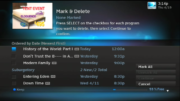If you’re tired of pressing the same remote buttons over and over again, or if your equipment is hidden in an entertainment center or closet, you need an RF remote. RF remotes use the same kind of transmitters as cell phones and televisions, instead of the infrared transmitters found in most remote controls.
If you’re a DIRECTV customer, you might choose the RC65RB remote. It’s the same as your regular DIRECTV remote but is backlit and has RF transmission capabilities. Check first to see if you already have an RF remote — If the model number of your remote (found on the upper left of the remote) ends in an “R” or if there is an FCC ID sticker on the back of the remote, you already have an RF remote!
The system setup screens will help you program the remote. They are a little different depending on the combination of receiver and remote, but start with pressing {MENU} then selecting “Settings and Help” then “Settings” then “Remote Control.” DIRECTV receivers can be either IR or RF but not both.
If you have a new THR22 you already have an RF remote. The setup screens will tell you how to configure it.
For any other system, you might consider the NextGen Remote Extender. This little device will turn any remote into an RF remote. We’ve reviewed it here (part 1) and here (part 2.) The RF transmitter replaces one of the batteries and it really works.
Spending a little time, and maybe a little money, can end the frustration of not getting good remote signals, permanently!





